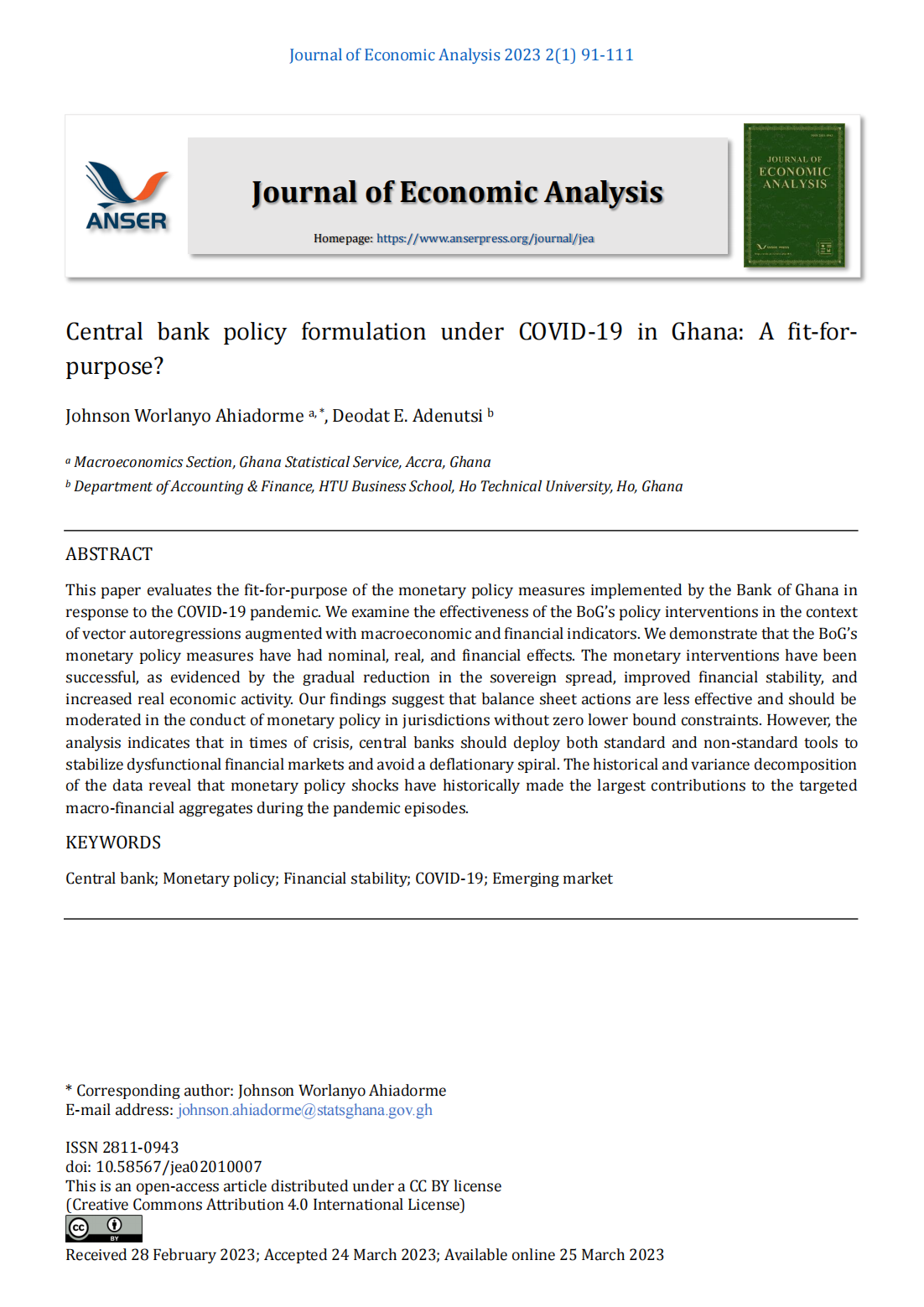Central bank policy formulation under COVID-19 in Ghana: A fit-for-purpose?
DOI:
https://doi.org/10.58567/jea02010007Keywords:
Central Bank, Monetary Policy, Financial Stability, COVID-19, Emerging MarketsAbstract
This paper evaluates the fit-for-purpose of the monetary policy measures implemented by the Bank of Ghana in response to the COVID-19 pandemic. We examine the effectiveness of the BoG’s policy interventions in the context of vector autoregressions augmented with macroeconomic and financial indicators. We demonstrate that the BoG’s monetary policy measures have had nominal, real, and financial effects. The monetary interventions have been successful, as evidenced by the gradual reduction in the sovereign spread, improved financial stability, and increased real economic activity. Our findings suggest that balance sheet actions are less effective and should be moderated in the conduct of monetary policy in jurisdictions without zero lower bound constraints. However, the analysis indicates that in times of crisis, central banks should deploy both standard and non-standard tools to stabilize dysfunctional financial markets and avoid a deflationary spiral. The historical and variance decomposition of the data reveal that monetary policy shocks have historically made the largest contributions to the targeted macro-financial aggregates during the pandemic episodes.
References
Baumeister, C. and Benati, L., (2013). Unconventional Monetary Policy and the Great Recession: Estimating the Macroeconomic Effects of a Spread Compression at the Zero Lower Bound. International Journal of Central Banking, 9(2), pp.165-212. https://www.ijcb.org/journal/ijcb13q2a9.pdf
Benigno, G., Hartley, J., Herrero, A.G., Rebucci, A. and Ribakova, E., (2020). Should Emerging Economies Embrace Quantitative Easing during the Pandemic? (No. 20201002). Federal Reserve Bank of New York.
Benmelech, E. and Tzur-Ilan, N., (2020). The Determinants of Fiscal and Monetary Policies during the COVID-19 crisis. Working Paper No. 27461, National Bureau of Economic Research, 1050 Massachusetts Avenue, Cambridge. https://www.nber.org/papers/w27461
Bernanke, B. (2020). New Tools of Monetary Policy, American Economic Rview, 110(4): 943-83. https://doi.org/10.1257/aer.110.4.943
Bernoth, K., Dany-Knedlik, G. and Gibert, A., (2020). ECB and Fed Monetary Policy Measures against the Economic Effects of the Coronavirus Pandemic Have Little Effect (No. 3). DIW Berlin, German Institute for Economic Research. https://www.econstor.eu/handle/10419/219096
Bhattarai, S, and Neely, C. J., (2022). An Analysis of the Literature on International Unconventional Monetary Policy. Journal of Economic Literature, 60 (2): 527-97. https://doi.org/10.1257/jel.20201493
Blot, C., Bozou, C. and Creel, J., (2021). Monetary Policy During the Pandemic: Fit for Purpose? Publication for the committee on Economic and Monetary Affairs, Policy Department for Economic, Scientific and Quality of Life Policies, European Parliament, Luxembourg. https://doi.org/10.1429/103964
D’Amico, S. and King, T.B., (2013). Flow and Stock Effects of Large-Scale Treasury Purchases: Evidence on the Importance of Local Supply. Journal of Financial Economics, 108(2), pp.425-448. https://doi.org/10.1016/j.jfineco.2012.11.007
Dell'Ariccia, G., Rabanal, P. and Sandri, D., (2018). Unconventional Monetary Policies in the Euro Area, Japan, and the United Kingdom. Journal of Economic Perspectives, 32(4), pp.147-72. https://doi.org/10.1257/jep.32.4.147
Demirgüç-Kunt, A., Pedraza, A. and Ruiz-Ortega, C., (2020). Banking Sector Performance during the COVID-19 Crisis. Journal of Banking & Finance, p.106305. https://doi.org/10.1016/j.jbankfin.2021.106305
English, B., Forbes, K. and Ubide, A. (Eds.) (2021), Monetary Policy and Central Banking in the COVID Era, CEPR Press.
Fawley, B.W. and Neely, C.J., (2013). Four Stories of Quantitative Easing. Federal Reserve Bank of St. Louis Review, 95(1), pp.51-88.
Feldkircher, M., Huber, F. and Pfarrhofer, M., (2021). Measuring the Effectiveness of US Monetary Policy during the COVID‐19 Recession. Scottish Journal of Political Economy, p.287-297. https://doi.org/10.1111/sjpe.12275
Gagnon, J., (2016). Quantitative Easing: An Underappreciated Success. PIIE Policy Brief, 16. https://www.piie.com/sites/default/files/documents/pb16-4.pdf
IMF 2020. World economic outlook, April (2020): the great lockdown. IMF, Washington DC.
Joyce, M., A. Lasaosa, I. Stevens, and M. Tong. (2011). The Financial Market Impact of Quantitative Easing in the United Kingdom. International Journal of Central Banking 7 (3): 113–61.
Karson, E. and Neely, C.J., (2021). More Stories of Unconventional Monetary Policy. Federal Reserve Bank of St. Louis Review, 103(2), pp.207-270. https://doi.org/10.20955/r.103.207-70
Kiley, M.T. and Roberts, J.M., (2017). Monetary Policy in a Low Interest Rate World. Brookings Papers on Economic Activity, 2017(1), pp.317-396. https://doi.org/10.1353/eca.2017.0004
Krishnamurthy, A. and Vissing-Jorgensen, A., (2011). The Effects of Quantitative Easing on Interest Rates: Channels and Implications for Policy. Brookings Papers on Economic Activity, pp.215-288. https://www.nber.org/papers/w17555
Kuttner, K.N., (2018). Outside the Box: Unconventional Monetary Policy in the Great Recession and Beyond. Journal of Economic Perspectives, 32(4), pp.121-46. https://doi.org/10.1257/jep.32.4.121
Ortmans, A. and Tripier, F., (2020). COVID-Induced Sovereign Risk in the Euro Area: When Did the ECB Stop the Contagion? Working Papers 2020-11, CEPII Research Centre, Paris
Pesaran, H.H. and Shin, Y., (1998). Generalized Impulse Response Analysis in Linear Multivariate Models. Economics Letters, 58(1), pp.17-29. https://doi.org/10.1016/S0165-1765(97)00214-0
Rebucci, A., Hartley, J.S. and Jiménez, D., (2020). An Event Study of COVID-19 Central Bank Quantitative Easing in Advanced and Emerging Economies. Working Paper No. 27339, National Bureau of Economic Research, 1050 Massachusetts Avenue, Cambridge.
United Nations Framework Report (2020), A UN framework for the immediate socio-economic response to COVID-19, available at: https://www.un.org/sites/un2.un.org/files/un_framework_report_on_covid-19.pdf
Walsh, C.E. (2010), Monetary Theory and Policy, 3rd ed., The MIT Press, Massachusetts.

Downloads
Published
How to Cite
Issue
Section
License
Copyright (c) 2023 Johnson Worlanyo Ahiadorme, Deodat E. Adenutsi

This work is licensed under a Creative Commons Attribution 4.0 International License.



